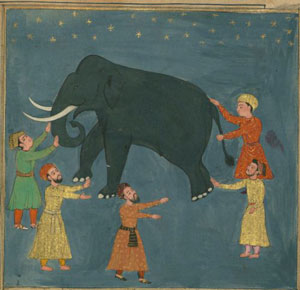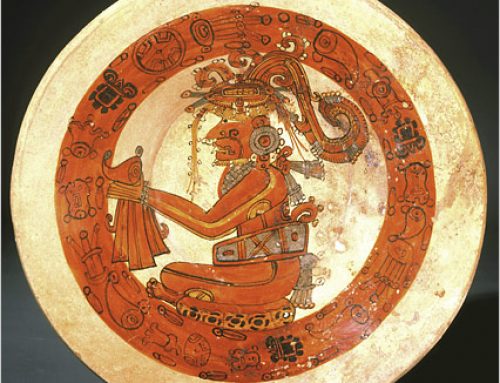
Mughal painting of the blind men and the elephant, from the 1600s AD (now in Walters Art Museum)
A story that’s a metaphor
Once there was an elephant, a tame elephant. He had been captured when he was a baby and taught to stand still and not worry much about people. So he was standing there, tied to a stake in the ground, minding his own business. Along came six blind men, who were out for a walk together. They couldn’t see anything so they bumped right into the elephant: bump!
Animals in India
Jataka tales
More Indian stories
All our ancient India articles
What can we really know?
“What is this thing we’ve bumped into?” they wondered. Each one touched the part of the elephant nearest him to try to figure it out. “I think this must be a rope,” said one of the men, holding on to the elephant’s tail. Another man felt the elephant’s leg. “No, it’s a pillar,” he said. A third man groped around and got hold of the elephant’s trunk said, “No, it’s a tree with many branches,” and the fourth man happened to feel the elephant’s ear, and thought this must be a fan. The fifth man, touching the side of the elephant, thought the others were silly. “No, it’s a wall,” he insisted. But the last man disagreed with all his friends. “It’s a hard pipe,” he said, holding the elephant’s tusk.
Where did the story come from?
The story of the blind men and the elephant may have first been told by the Buddha, about 500 BC. Later Buddhists and Jains and Sufi people told this story to show how nobody can really know the truth, or not the whole truth. You could compare it to Plato’s parable of the cave.
Buddhism in India
Who are the Sufis?
Plato’s parable of the cave
If the Buddha really told this story, it was about a hundred years before Plato told his parable. The first written version of the story dates to 29 BC, or three hundred years after Plato.
Isn’t this story ableist about blind people?
Yes, it is. It’s an old story, and today we would tell it without involving blindness. For example, we might tell this story about people who were blindfolded, or who were in a dark room.




